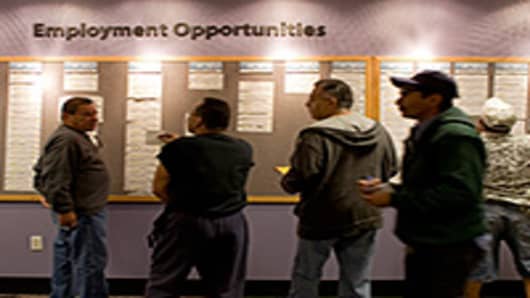The U.S. unemployment rate of 8.1 percent is probably double that number when you include a host of measures of the jobless rate that are not included in the official data, one professional tells CNBC.
The state of the U.S. labor market is in focus because the Federal Reservesaid last week that until there are significant improvements in the sector, the central bank would continue to buy mortgage and other assets in order to revive economic growth.
But the problem, says CEO of Richmond Asset Management in Hong Kong, Graham Bibby, is that the level of unemployment in the U.S. is probably worse than the Fed thinks it is, with the jobless rate probably closer to 16 percent when you look at other measures not used to compile the official number.
“For example, if you have been unemployed for 12 months, given some other criteria, and you haven’t been to the unemployment exchange, you haven’t been to interviews, you haven’t been looking at job adverts etc., you drop off the official unemployment numbers because you are not viewed as actively looking for employment. But technically, you are not employed,” Bibby said on CNBC Asia’s “Squawk Box”.
“Then there are statistics at the short-end such as how long you have to be unemployed before you are considered unemployed, and if you get a part-time job when you were looking for a full-time job, you also drop off the statistics. So the stats are quite a lot higher then they look,” he added.
The U.S. unemployment rate fell to 8.1 percent in August from 8.3 percent. Still, the jobless rate has remained above 8 percent since early 2009 and has remained stubbornly high – even with earlier monetary stimulus from the Fed and interest rates close to zero.
Bibby says the unemployment numbers will be key to the direction of financial markets because right now markets are rallying on hopes that the Fed’s monetary stimulus will boost economic growth and bring down unemployment.
That expectation may last for a few more months, but with unemployment likely to stay high for much longer than that, the stellar rally in stock markets may start to unwind, he adds.
The Dow Jones industrial average and the S&P 500 on Friday closed at their highest level in almost five years, buoyed by the Fed’s decision a day earlier to embark on another round of monetary stimulus.
“What the Fed has announced is so extreme, so there is underlying support for markets, at least for 2-3 months,” Bibby said. “If the unemployment rate came back from 8.1 percent to say 7.8-7.6 percent, then the rally would continue. But if it sticks at 8.1 percent and a few months go by, and you need a few months to get these figures, then people will start to get concerned.”
- By CNBC's Dhara Ranasinghe


